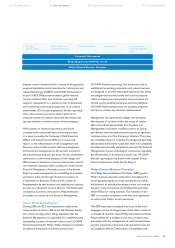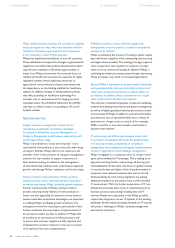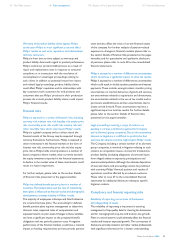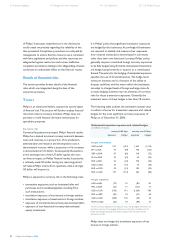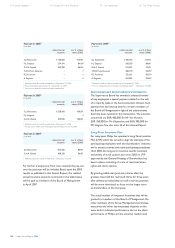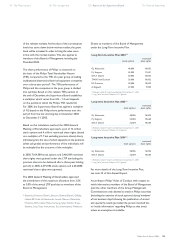Philips 2006 Annual Report Download - page 95
Download and view the complete annual report
Please find page 95 of the 2006 Philips annual report below. You can navigate through the pages in the report by either clicking on the pages listed below, or by using the keyword search tool below to find specific information within the annual report.
Philips Annual Report 2006 95
as back-up for short-term fi nancing requirements that
would normally be satisfi ed through the Commercial
Paper Program and EUR 9,524 million of investments
in its main available-for-sale securities, trading securities
and listed equity-accounted investees at market value
per December 31, 2006. The Company has a lock-up
period associated with the sale of shares in TPV that
expires in September 2008. Furthermore, the LG.Philips
LCD shareholders agreement with LG Electronics, states
that both companies will maintain a holding of at least
30% each until July 2007.
Equity price risk
Philips is a shareholder in several publicly listed companies
such as TSMC, LG.Philips LCD, TPV and JDS Uniphase.
As a result, Philips is exposed to potential fi nancial loss
through movements in the share prices of these companies.
The aggregate equity price exposure of these investments
amounted to approximately EUR 9,524 million at year-
end 2006 (2005: EUR 11,252 million including shares that
were sold during 2006). Philips also holds options on the
shares of TPV through a convertible bond issued to Philips
in September 2005, the face value of the bond being the
USD equivalent of EUR 160 million and the value of the
option at year-end EUR 40 million. Philips does not hold
derivatives in its own stock, or in the above-mentioned
listed companies except for the embedded derivatives
in the convertible bond as mentioned.
Commodity price risk
Philips is a purchaser of certain base metals, precious
metals and energy. Philips hedges certain commodity price
risks using derivative instruments to minimize signifi cant,
unanticipated earnings fl uctuations caused by commodity
price volatility. The commodity price derivatives that
Philips enters into are concluded as cash fl ow hedges
to offset forecasted purchases. A 10% increase in the
market price of all commodities would increase the
fair value of the derivatives by EUR 2 million.
Credit risk
Credit risk represents the loss that would be recognized
at the reporting date if counterparties failed completely
to perform their payment obligations as contracted.
Credit risk is present within the trade receivables
of Philips. To reduce exposure to credit risk, Philips
performs ongoing credit evaluations of the fi nancial
condition of its customers and adjusts payment terms
and credit limits when appropriate.
Philips invests available cash and cash equivalents with
various fi nancial institutions and is exposed to credit risk
with these counterparties. Philips is also exposed to credit
risks in the event of non-performance by counterparties
with respect to fi nancial derivative instruments.
Philips actively manages concentration risk and on a daily
basis measures the potential loss under certain stress
scenarios, should a fi nancial counterparty default. These
worst-case scenario losses are monitored and limited
by the company. As of December 31, 2006 the company
had credit risk exceeding EUR 25 million to the following
number of counterparties:
Credit risk with number of counterparties
25-100
million
100-500
million
500-1,500
million
AAA-rated bank counter-
parties 1 − 1
AAA-rated money market
funds 2 − −
AA-rated bank counterparties 2 6 2
A-rated bank counterparties 1 − −
Non-rated money market
funds − 1 −
Lower-rated bank counter-
parties in China 2 − −
The company does not enter into any fi nancial derivative
instruments to protect against default by fi nancial
counterparties. However, where possible the company
requires all fi nancial counterparties with whom it deals
in derivative transactions to complete legally enforceable
netting agreements under an International Swap Dealers
Association master agreement or otherwise prior to
trading and, whenever possible, to have a strong credit
rating from Standard & Poor’s and Moody’s Investor
Services. Wherever possible, cash is invested and fi nancial
transactions are concluded with fi nancial institutions
with strong credit ratings.
Country risk
Philips is exposed to country risk by the very nature
of running a global business. Country risk is the risk
that political, legal, or economic developments in a single
country could adversely impact our performance. The
country risk per country is defi ned as the sum of equity
of all subsidiaries and associated companies in country
cross-border transactions, such as intercompany loans,
54 The Philips sectors 86 Risk management 100 Report of the Supervisory Board 110 Financial Statements




